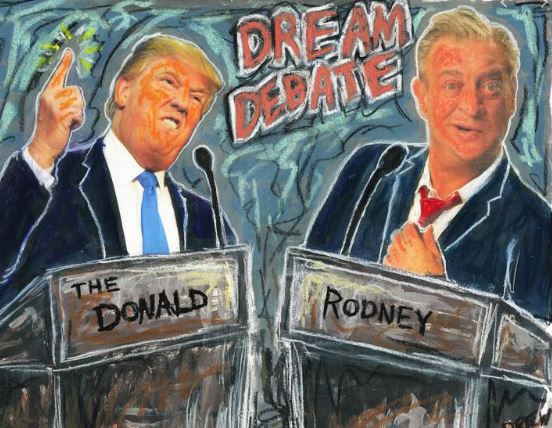
Source: Saatchi Art/Google Images
By Michael O’Neill
Is Fed Chair Jerome Powell the “Rodney Dangerfield” of central bank leaders? It certainly looks that way. Mr Dangerfield claimed, “I get no respect,” during a sixty-eight year comedy career. He was being funny. Mr Powell has only been in his post for nineteen months and has been slagged by President Trump for fourteen of them. Trump isn’t being funny.
On September 18, the Fed cut interest rates by 0.25%., lowering the fed funds range to 1.75-2.0%. The vote was not unanimous. St Louis Fed President James Bullard wanted a 0.50% cut while Kansas City Fed President Esther George, and Boston Fed President Eric Rosengren preferred rates to be left unchanged. The dot-plot projections were less ambiguous. They suggested that further rate cuts would not be forthcoming the rest of this year and all of 2020. That news got “the Donald’s” dander up.
Within moments of the FOMC statement being released, Trump tweeted “Jay Powell and the Federal Reserve Fail Again. No “guts,” no sense, no vision! A terrible communicator!”
The President may have been irritated. Traders, not so much. The US dollar edged higher, but still closed the day well-inside its recent ranges. Wall Street finished the session almost unchanged, and the 2s/10s Treasury yield curve steepened. Gold prices plunged because Fed policy may be on hold and oil prices were steady.
Mr Powell repeated that the Fed does not have a monetary policy bias and that future rate decisions will be determined by incoming data “including measures of labor market conditions, indicators of inflation pressures and inflation expectations, and readings on financial and international developments.”
President Trump’s dissatisfaction with the Fed’s actions may be valid. The September 18, 2019 interest rate cut dropped the fed funds rate to the level they were at on September 17, 2018. At that time, the Fed dot-plot forecast predicted four rate increases by the end of 2019. Since then the Fed increased rates twice and cut them twice. The net result is that US interest rates are unchanged, year over year.
Meanwhile,other central banks have lowered their benchmark rates during the same period. The European Central Bank dropped its deposit facility rate to negative 0.50% from 0.40% while announcing a new quantitative easing program, last week. The Reserve Bank of New Zealand slashed rates by 0.50% to 1.00% on August 7, following a 0.25% reduction in May. At the beginning of July, the Reserve Bank of Australia sliced its overnight cash rate to 1.00%, after a 0.25% cut in June. A host of emerging market central banks have crashed the rate cutting party, as well. The Bank of Japan and China are rumoured to be readying new stimulus measures to combat slowing growth. Score “one” for Mr Trump.
President Trump’s criticism of the Fed’s monetary policy is his attempt to address what he believes is an underperforming economy. If so, he is treating a symptom. He should be treating the cause and that cause is in the Oval office at 1600 Pennsylvania Ave, Washington DC.
The common theme in the monetary policy statements of the central banks that have lowered interest rates is “slowing global growth due to trade disputes.” The Bank of Canada is worried about the escalating US/China trade conflict, blaming it for slowing global economic momentum. Some economists believe the BoC may be forced to follow in the footsteps of the ECB, RBA and RBNZ.
President Trump is the ring-master of the trade war circus, shredding existing trade agreements, orchestrating new trade wars, and threatening tariffs on any country that shows up on his radar. Perhaps if he dialed back on his inflammatory trade rhetoric, global tensions would ebb and the necessity for lower interest rates would fade.
There are signs that the US and China trade tensions may be easing. On September 11, China announced exemptions for sixteen US products including pork and soybeans. President Trump reciprocated by delaying the next round of tariff increases on Chinese imports to October 15, from October 1. He said it was a “goodwill gesture” in honour of China’s National Day. The two sides meet in Washington in October for more face-to-face talks.

Source: Campbells Soup Co/IFXA
Even as the US/China tensions eased, somewhat, Middle East tensions escalated. On September 15, Saudi Arabia oil fields were bombed in a drone attack. Initial reports said that about 5% of global crude production was impacted and oil prices spiked. That move quickly faded after Saudi officials reported that the damage was not extensive, and that full-production would resume quickly. Oil prices retreated but quickly found a floor when the blame game began.
Yemeni Houthi rebels who are fighting Saudi Arabia took credit for the attack, but Saudi Arabia and the US still blame Iran. On September 18, US Secretary of State Mike Pompeo said it was “an act of war.” President Trump ordered new sanctions on Iran.
The world should hope for cooler heads to prevail. Cynics remember US Secretary of State Colin Powell’s address to the UN on February 5, 2003, when he justified an invasion of Iraq because of Saddam Hussein’s possession of “weapons of mass destruction. As he later discovered, the only “weapons of mass destruction” in Iraq, were the coalition forces that laid waste to the country.
Fed Chair Jerome Powell and Iran’s Supreme Leader Ali Khamenei may soon be echoing Rodney Dangerfield’s’ complaint: “I get no respect.”





